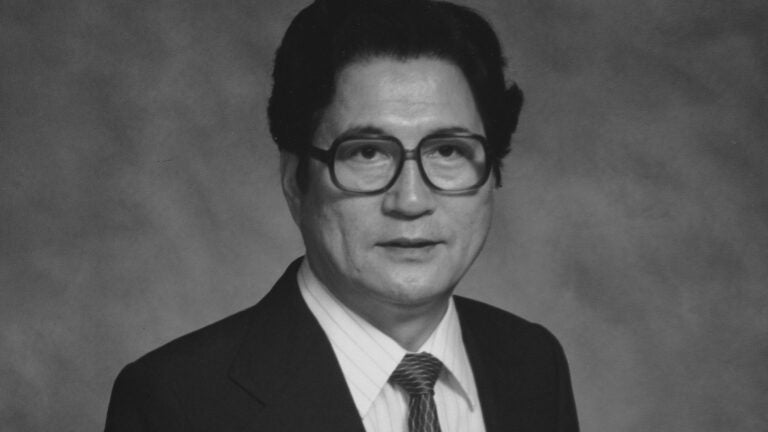
In Memoriam: Young Bae Kim, 93
Young Bae Kim, professor of physics and electrical engineering, has died. He was 93.
Kim died of natural causes on July 7 at his home in West Los Angeles.
Joining the USC faculty in 1968, Kim focused his research in the fields of low-temperature physics, cryogenic engineering and superconductivity. He was renowned among scientists investigating superconductivity materials, publishing more than 70 technical papers on the subject. Many of the empirical laws in high-field superconductivity — in which superconducting materials help produce exceptionally strong magnetic fields — bear his name.
In the early days of his USC Dornsife career, Kim collaborated with Emeritus Professor of Physics and Astronomy Melvin Daybell.
“Kim and I came to USC in 1967 and ’68 as part of a push to build a stronger physics department at USC,” Daybell said. “He came from Bell Labs where he was a leading member of a group of experimentalists working with their strong theory staff in the rapidly advancing field of type II superconductors, especially in the presence of high magnetic fields. This was before the discovery in of materials that could remain superconductors at much higher temperatures than the 20 degrees above absolute zero that could be reached at the time.”
The pair built a highly successful research group that used a dilution refrigerator capable of reaching 30 millidegrees Kelvin — just three one-thousandths of a degree above the point where all atomic motion freezes. They also investigated diluted magnetic alloys, recruiting a number of expert faculty into the group.
“Kim helped me establish an ultra-low temperature lab based on my work at Los Alamos, and over the next few years he built USC’s efforts into a strong presence in various aspects of condensed matter physics at low and ultra-low temperatures,” Daybell said.
Kim also headed USC’s Energy Resources Laboratory, which he founded in 1971, and he was active in research related to electric power transmission.
His USC career spanned more than 20 years, in which he served as chair of the Department of Physics from 1975–79. He left briefly to serve as a visiting professor at the Korea Advanced Institute of Science in Daejeon, South Korea, from 1973–74, and again from 1980–82 to become director of the U.S. Office of Naval Research in Tokyo, Japan. He then returned to USC, remaining until his retirement in 1991.
Stephan Haas, professor of physics and astronomy and current department chair, noted the importance of Kim’s research efforts to USC and to the field of physics, as well as his strengths as a teacher.
“During his professional life, he made several seminal contributions in condensed matter physics, which are documented by a significant number of publications in high-caliber journals,” Haas said. “Furthermore, he and his coworker originated several patents related to superconducting magnets and switches. It is probably fair to say that he built the first persistent high-field magnets.
“Young Bae is well remembered for his kindness with students, dedication to teaching, and his pursuit to build a vibrant physical sciences community at USC. We would certainly not be in the international leadership position in which we are now without his tireless dedication to our community.”
Kim was born in Seoul, Korea, on Oct. 23, 1922. He attended Seoul Technical College and went on to become a high school math teacher and then principal.
After World War II, he applied through a scholarship program to attend college in the United States. During the application process, he earned the third highest math scores in Korea and the right to attend the University of Washington in Seattle, where he obtained his Bachelor of Science in physics in 1950.
He earned his Ph.D. from Princeton University in ’54 and then returned to the University of Washington as associate professor, a position he held from 1955–61. He went on to conduct research at Bell Labs from 1961–68. There, he and Philip Anderson, who would go on to win the Nobel Prize in Physics in 1976, developed a highly influential principle in superconductor physics dubbed the Kim-Anderson theory.
Near the end of his tenure at Bell Labs, Kim spent a year as a visiting professor at Tokyo University on a Guggenheim Fellowship. He was a Fellow of the American Physical Society.
Kim is survived by his wife, Janis Kim; his daughter, Ellie Perry; his two sons, Eden and Evan Kim; and three grandchildren.
Perry remembers her father as a modest, virtuous man who was dedicated to the greater good, likening him to a legendary ancient Roman leader.
“When I think of an example or story to summarize my father’s life, what comes to mind is the legend of a famous Roman from 500 B.C. named Lucius Quinctius Cincinnatus,” Perry said. A brilliant military commander, Cincinnatus was twice called upon to save the Roman Empire from invaders and granted absolute power and authority to do so. After resolving each crisis, he immediately resigned, relinquishing his near-absolute authority and returning to a simple life of farming.
“As a result, Cincinnatus has often been cited as an example of outstanding leadership, service to the greater good, civic virtue, lack of personal ambition, and modesty,” Perry explained. “I was only four when my father retired from USC … with most of his great professional accomplishments already behind him. But his dedication to the greater good, his modesty, and emphasis on living a virtuous life never left him, and I could see it in the way he tried to impart those values onto me growing up.”
Per his final wishes, Kim’s ashes will be scattered in the Pacific Ocean on what would have been his 94th birthday, so he can “travel the world.” Memorial donations may be made to the family for redistribution to a variety of charitable causes at youngbkimmemorialfund.mydagsite.com.
A memorial is scheduled for July 28 at 11 a.m. in the University Religious Center on the University Park Campus.